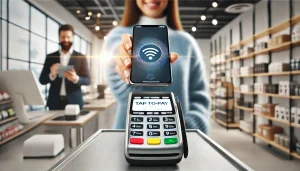Over the past few years, technological advancements have fundamentally transformed the landscape of financial transactions in the United States. The emergence of digital banking platforms and the widespread use of credit and debit cards have profoundly reshaped personal finance, altering the way consumers and businesses interact with financial institutions.
Anúncios
This article delves into the significant influence of technology on digital accounts and cards in the US, analyzing their benefits, challenges, and future prospects. As these innovations continue to expand, understanding their implications becomes increasingly vital for individuals and businesses navigating the constantly evolving realm of modern finance.
The ascendancy of digital banking in the USA

Evolution of digital banking services
The surging demand for convenient and efficient financial solutions has propelled a rapid evolution in digital banking services. Traditional brick-and-mortar banks are swiftly embracing digital platforms, offering customers an extensive array of online and mobile banking features. This shift has led to a more customer-centric banking experience, where users can conduct financial transactions without the need for physical visits to bank branches.
From seamless account management to hassle-free bill payments and swift fund transfers, digital banking has seamlessly integrated into the daily routines of millions of Americans. Mobile banking apps now allow users to deposit checks remotely, set up automated bill payments, and even receive real-time spending insights. The adoption of artificial intelligence (AI) and machine learning further enhances these services, offering predictive analytics and fraud detection mechanisms that protect consumers from financial threats.
This transformation underscores a pivotal shift in the financial landscape, where accessibility and agility reign supreme, reshaping the way individuals interact with and manage their finances in the modern era.
Advantages of Digital Accounts and Cards
Digital banking and payment cards have introduced a multitude of benefits for consumers and businesses alike. These advantages include:
- Accessibility: Digital banking platforms provide unparalleled accessibility, enabling customers to manage their finances anytime, anywhere, using their smartphones or computers. This convenience reduces dependency on physical branches and allows users to conduct financial transactions at their own pace.
- Cost-effectiveness: Digital accounts often come with lower fees and charges compared to traditional banking services, making them an appealing choice for cost-conscious consumers. Online-only banks, in particular, eliminate overhead costs associated with physical locations, translating to better financial terms for customers.
- Enhanced security: Advanced encryption technologies and multi-factor authentication protocols have significantly bolstered the security of digital banking transactions, mitigating the risk of fraud and identity theft. Contactless payment methods, such as mobile wallets, further reduce exposure to card skimming and other fraudulent activities.
- Seamless integration: Digital banking platforms seamlessly integrate with other financial management tools and applications, offering users a holistic view of their finances and facilitating better decision-making. Personal finance apps can sync with bank accounts, track spending habits, and provide financial recommendations.
- Personalized experiences: Through data analytics and machine learning algorithms, digital banks can provide personalized recommendations and insights tailored to each customer’s financial goals and preferences. Users receive customized alerts, savings suggestions, and investment advice based on their spending patterns.
Challenges and Concerns
Despite the numerous benefits of digital banking and cards, several challenges and concerns persist:
- The Digital Divide: One major issue is the digital divide, which denotes the gap between those with access to digital technologies and those without. Vulnerable populations, such as the elderly and low-income individuals, may struggle to adopt digital banking due to a lack of access to technology or digital literacy skills.
- Cybersecurity Threats: As cybercriminals become increasingly sophisticated, financial institutions must continuously invest in robust cybersecurity measures to safeguard customer data and prevent unauthorized access. Phishing attacks, ransomware, and identity theft are ongoing risks in the digital banking landscape.
- Privacy Concerns: The collection and use of personal data by digital banks and card issuers raise privacy concerns. Customers may worry about the potential misuse of their information or the lack of transparency regarding data-sharing practices. Ensuring compliance with data protection regulations and reinforcing ethical practices in data handling are crucial steps toward maintaining consumer trust.
Future Outlook
Looking ahead, the future of digital banking and cards in the United States appears exceedingly promising. Technological advancements, including blockchain, artificial intelligence, and biometric authentication, are poised to catalyze another wave of transformation in the industry. These innovations promise heightened levels of security, efficiency, and convenience for consumers, setting the stage for a more seamless and personalized banking experience.
- Blockchain Technology: The implementation of blockchain technology could revolutionize digital transactions by providing decentralized, tamper-proof records that enhance transparency and security. Smart contracts and decentralized finance (DeFi) platforms have the potential to reshape the traditional banking model.
- Artificial Intelligence and Automation: AI-driven chatbots and virtual assistants are expected to enhance customer service experiences, offering instant support and automating routine banking tasks. AI can also improve fraud detection by analyzing patterns and identifying suspicious activities in real time.
- Biometric Authentication: The adoption of biometric authentication methods, such as facial recognition and fingerprint scanning, is expected to enhance security measures in digital banking. These technologies reduce the risk of unauthorized access and provide a more seamless login experience for users.
Moreover, the ongoing shift towards a cashless society is expected to accelerate the adoption of digital payment solutions, driving the growth of digital banks and fintech companies. As businesses and consumers increasingly favor digital transactions over cash-based payments, the demand for secure, efficient, and innovative financial solutions will continue to grow.
However, it is essential for policymakers and industry stakeholders to address the digital divide and ensure that all Americans have access to affordable and inclusive financial services. Expanding digital literacy programs and improving infrastructure in underserved areas can help bridge this gap and create a more equitable financial ecosystem.
Conclusion
In conclusion, the impact of technology on digital banking and cards in the United States has been profound and far-reaching. While the transition to digital platforms has brought numerous benefits such as accessibility, cost-effectiveness, and enhanced security, it also presents challenges regarding cybersecurity, privacy, and inclusivity.
As technology progresses, it becomes increasingly imperative for stakeholders to collaborate and innovate, ensuring that digital financial services uphold principles of accessibility, security, and fairness for all Americans. By collectively addressing these challenges, we can harness the full potential of technology to build a financial ecosystem that caters to the diverse needs of society while guarding against emerging risks.
Through continuous investment in technology, policy reforms, and consumer education, the future of digital banking in the United States holds immense potential for financial empowerment, security, and innovation.






